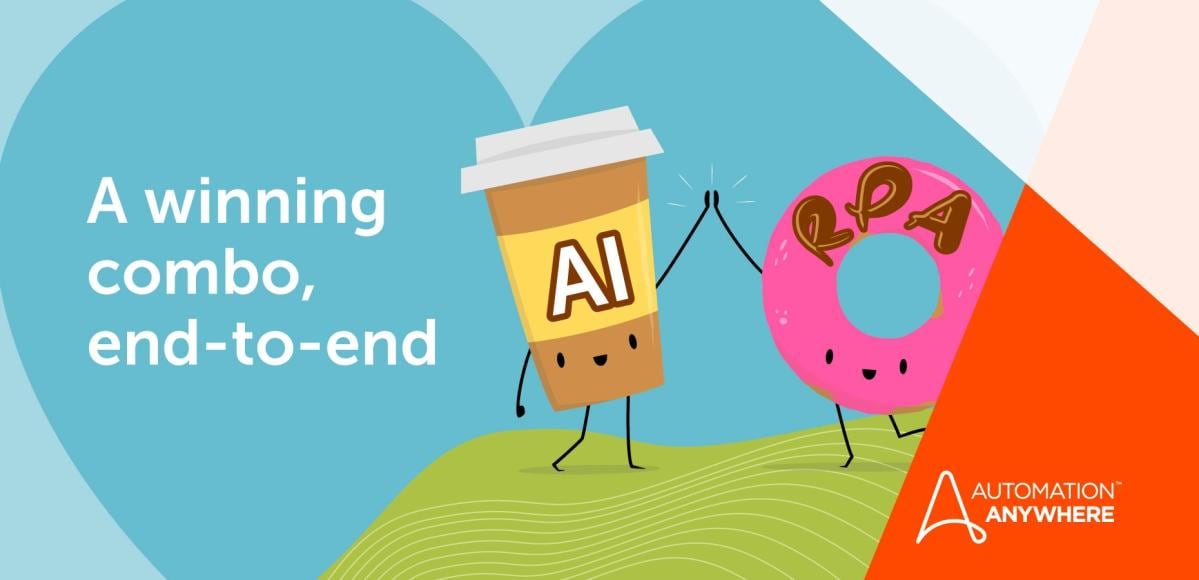Blog
How Do AI and RPA Work Together?
Share this:

Artificial intelligence (AI) and Robotic Process Automation (RPA) have a lot in common. They’re both increasingly popular technologies, with enterprise installations accelerating year after year. They both promise to revolutionize companies striving for digital transformation. And they both, until now, have been relegated to silos within organizations, requiring highly skilled — yet scarce — practitioners to successfully deploy them.
When combined, AI and RPA technologies result in intelligent automation that empowers rapid end-to-end business process and much more.
Technology that has come of age
Artificial intelligence has been around since the 1960s. It refers to machines, most often computers, performing tasks that used to require human intelligence to accomplish. Today, AI is transforming how people live and work, infused into solutions across industries and environments.
Automating tasks
The word “robot” in Robotic Process Automation doesn’t refer to a physical robot or an AI robot. It’s a software robot, or bot, that automates mundane, repetitive tasks and processes, eliminating human error and increasing productivity and efficiency to a significant degree.
RPA bots automate all rule-based tasks. Moreover, they can copy/cut and paste data, routinely move files and folders, scrape web browsers, fill in forms, and extract data from documents.
Bots complete tasks according to the rules specified by an RPA-qualified worker, or they can leverage built-in AI capabilities. RPA can improve efficiency in a wide range of fields such as human resources, financial services, healthcare, supply chain management, customer service, accounting, data entry, and more.
Today’s process automation is a great fit for businesses, offering:
- User-friendliness — it’s easy to set to operate
- Flexibility — able to adapt to your organization's needs
- Non-disruptive — does not require significant changes to the workplace
- Scalability — can grow to accommodate increasing work
- Centralization — bots are controllable from a central location
- Ease of use — no programming expertise is required
- Security — ironclad and foolproof protection
Applications of AI and RPA
While they have a lot in common, artificial intelligence and Robotic Process Automation are two different technologies. RPA is incredibly efficient, but it does only what the user or programmer tells it to do, while an AI can teach itself. RPA can automate all the rule-based tasks, and AI can bridge the gap where RPA falls short.
RPA deals with structured data. AI is used to gather insights from semi-structured and unstructured data in text, scanned documents, webpages, and PDFs. AI brings value by processing and converting the data to a structured form for RPA to understand.
How and why AI and RPA can be combined
The two technologies can support each other and can coexist in integration to form a more robust platform for intelligent automation — automating any front- or back-office business process and orchestrating work across combined human-bot teams.
Here are some of the reasons why you would use RPA and AI in a single package:
- Skyrocket the productivity of your workforce.
- Save your workforce of painful, tedious, agitating, and repetitive tasks.
- Eliminate human errors from the workplace and be sure to reach correct results.
- Improve data management more effectively and save costs.
- Acquire complete process transparency through a customized dashboard and customized reporting support.
AI and RPA a no longer limited to programmers. The technology is easily accessible to business users in form of intelligent automation.







